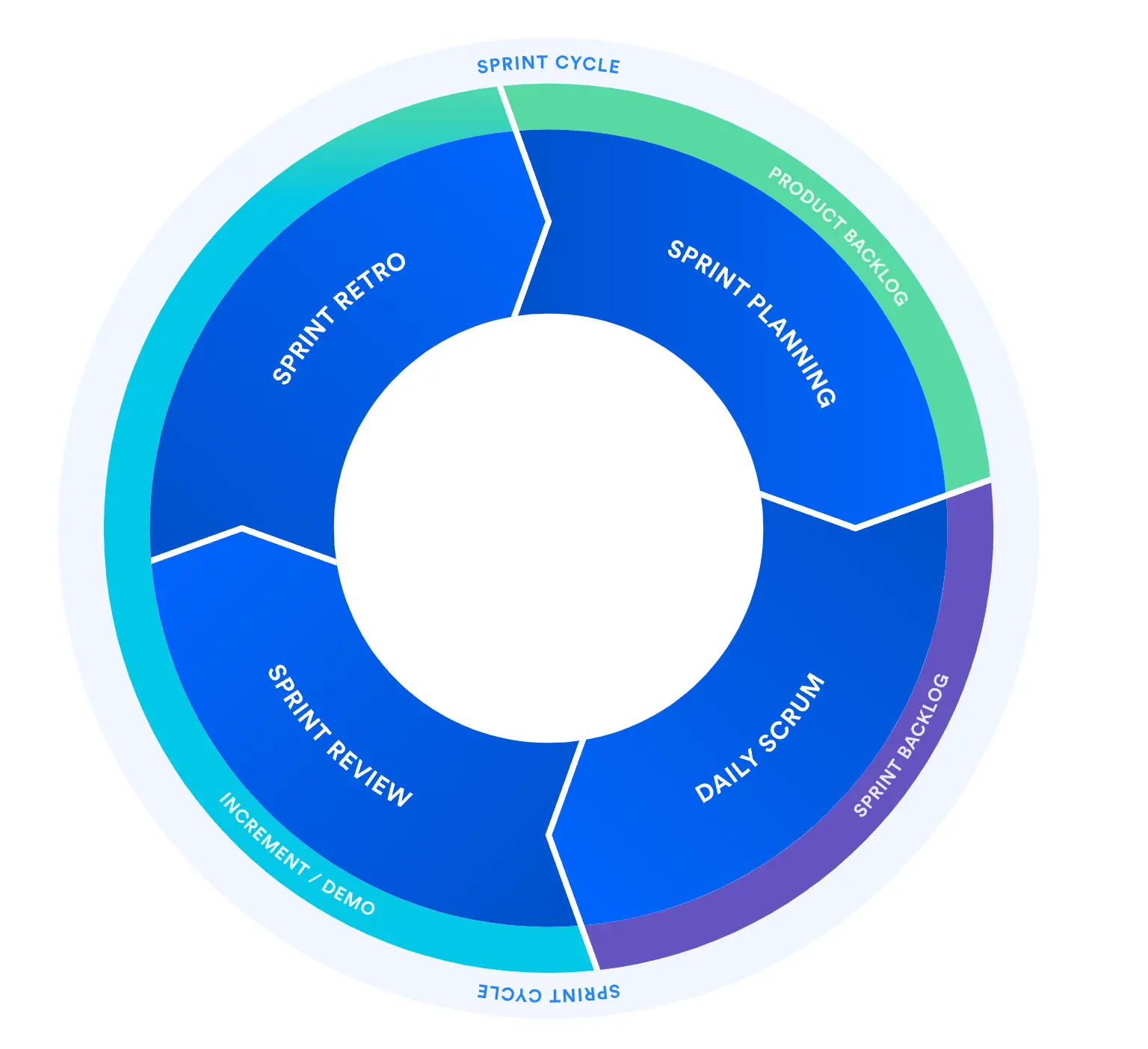If you’re new to product management or looking to break into the tech industry, chances are you’ve come across the Agile methodology and its range of concepts and jargon.
One such concept is the sprint—a short timeframe where a development team works towards predefined objectives. After each sprint, there’s a review period where stakeholders take the time to reflect on what has been accomplished and identify areas for improvement. This is known as the sprint review.
But what is a sprint review, exactly? How does it fit into the Scrum framework? And most importantly, how do you run a successful one? To answer these questions and more, we’ll cover the following topics:
- What is a sprint review?
- Sprint review FAQs
- Sprint review vs retrospective: 4 key differences
- How to run a sprint review
- Wrap-up
1. What is a sprint review?
Put simply, a sprint review is a brief assessment of the sprint’s outcome and any adjustments that need to be made going forward to ensure the team’s success.
But to understand what this means, we must first familiarize ourselves with the Scrum methodology. Scrum is an iterative and incremental framework for managing product development, and it’s based on the scrum sprint cycle.
The scrum cycle comprises five key stages:
- Sprint Planning—the first stage where the team identifies the goal of the sprint, selects the Product Backlog Items (PBIs) to be worked on during the sprint, and creates a sprint goal.
- Sprint Backlog—the stage where the team creates a plan for the sprint, breaking down selected PBIs into smaller tasks and estimating the time required to complete them.
- Daily Scrum—a short meeting held every day during the sprint for the team to synchronize their work, discuss progress, identify obstacles, and plan daily tasks.
- Sprint Review—the end-of-sprint stage where the team demonstrates the completed work to stakeholders, receives feedback and reviews the progress made towards achieving the sprint goal.
- Sprint Retrospective—the final stage where the team reflects on their performance during the sprint, identifies areas for improvement, and discusses what can be done differently in the next sprint. You can learn more about it in our full guide to sprint retrospectives.

Credit: Atlassian
As you can see, each iteration includes a review period. This is the sprint review meeting.
It’s a crucial working session that allows stakeholders to collaborate and evaluate their accomplishments throughout the sprint. The review also allows them to plan future tasks and determine the next steps in achieving their goals.
During the meeting, the scrum team goes over tasks that have been completed and those that remain incomplete.
They also examine any potential issues that may have arisen during the sprint and discuss solutions to those problems. This helps them improve the end product, their work processes, and the team dynamics.
2. Sprint review FAQs
To dive deeper into the world of sprint reviews, let’s address some frequently asked questions about them.
When should the sprint review happen?
The sprint review should happen after the sprint has ended but before the upcoming sprint planning meeting. This allows the team to review what was accomplished in the previous sprint and provide feedback for the next planning meeting.
Who runs the sprint review?
The sprint review is typically run by the scrum master, who facilitates the meeting. However, the scrum team presents the work they completed during the sprint, and the product owner provides an evaluation of the results.
What is the main purpose of a sprint review?
The main purpose of sprint review meetings is to evaluate what was accomplished during the sprint, identify necessary adjustments, and plan future tasks to achieve predetermined business goals.
How long is a sprint review?
The review length depends on the sprint cycle and the given meeting agenda, but typically it should not exceed four hours for a one-month sprint. The meeting agenda should include time for reviewing completed work, discussing issues, and planning for the next sprint.
Does the sprint review happen before or after release?
The sprint review happens after the sprint has ended but before the upcoming sprint planning meeting. This means it usually happens before release, but that’s not a requirement.
Is the sprint review mandatory?
Yes, the sprint review is mandatory for teams following the Scrum framework.
Can a product manager run the sprint review?
Yes, a product manager (PM) can theoretically run a sprint review. Generally, the scrum master is responsible for facilitating and moderating the meeting, but if the PM has experience with Scrum, they may also lead it.
3. Sprint review vs retrospective: 4 key differences
Although the sprint review and sprint retrospective both occur at the end of a sprint, they differ from each other in their purpose and focus.
As discussed, a sprint review is a meeting that takes place at the end of each sprint, with the primary goal being to inspect the work completed during that particular sprint.
This includes examining user stories, tasks, and other deliverables achieved within the timeline. The purpose of them is to demonstrate progress during a sprint cycle as well as gain feedback from key stakeholders.
By comparison, a sprint retrospective occurs after the completion of a sprint cycle. Its purpose is to allow team members to reflect on what has been achieved throughout the sprint process as a whole and develop strategies to accomplish goals more effectively.
In addition, participants can discuss any impediments they may have encountered during their work process and share ideas on how to address them in the following cycles.
Here is an overview of the most significant differences between the two events, categorized by purpose, participants, deliverables, and objectives.
| Sprint review | Sprint retrospective | |
| Purpose | Focuses on demonstrating completed work to stakeholders and receiving feedback. | Focuses on reflecting on the sprint and identifying areas for improvement. |
| Participants | Typically includes stakeholders, such as customers and product owners. | Typically includes only the development team. |
| Deliverables | Demonstration of completed work and plan for the next sprint. | Action plan for improving development process and addressing any issues or challenges from previous sprint cycle. |
| Objectives | Receive feedback from stakeholders about the completed work. | Identify areas of improvement in the development process and address any challenges that arose during the sprint cycle. |
4. How to run a sprint review
Understanding the meaning of the term “sprint review” is one thing. But if you’re tasked with running one yourself, you’ll need to know the practical steps involved.
To ensure the sprint review process runs as smoothly as possible, there are five main steps you should follow:
Set the meeting agenda
The first step in a successful sprint review is setting an agenda for the meeting. For this, lay out the topics that will be discussed and the timeframe for each one.
Make sure to give the team ample time to review their work, discuss any issues they may have encountered, and plan for the next sprint.
Demonstrate the completed work
Once the agenda has been set, it’s time for the development team to demonstrate any work that was completed during the sprint.
This allows stakeholders to see what progress has been made and gives them insight into potential changes they may wish to suggest.
Receive feedback from stakeholders
This is where stakeholders have their chance to provide valuable input on any work performed so far.
The purpose of this feedback is twofold: It creates accountability among those involved in the development and informs future sprints by providing helpful ideas and resources that can be used going forward.
Discuss and prioritize next steps
After receiving stakeholder feedback, it’s time for discussion amongst those involved to determine how future adaptations can be made based on what was learned from previous iterations.
During this step, it’s essential to establish priorities and ensure everyone understands their role in implementing changes as quickly and effectively as possible.
Conclude the sprint review meeting
After all agenda items have been discussed, it’s time to create an action plan based on everything that was discussed during the sprint review.
This includes setting priorities, assigning tasks, and establishing timelines for completion, along with determining who will be responsible for submitting reports at later stages,
5. Wrap-up
Sprint reviews are a necessary part of the Scrum framework, allowing agile teams to assess their progress and improve subsequent sprints.
In this article, we’ve examined the sprint review meeting in detail, from who should run it, when it happens in the sprint cycle, and most importantly, what its purpose is. We’ve also outlined five steps for running successful sprint reviews that help product managers and teams evaluate their progress, receive feedback, and identify opportunities for improvement.
Want to learn more about a possible career in product management? Check out this free 5-day introductory course. Or, if you prefer to keep on reading, here are some more articles you may find helpful:


